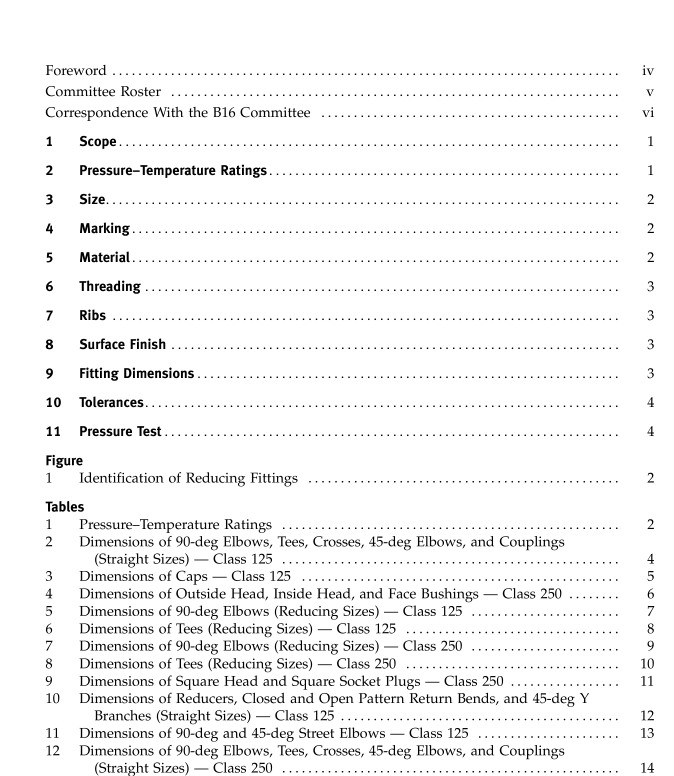ASME B16.15:2006 pdf free download Cast Copper Alloy Threaded Fittings Classes 125 and 250
1 sCOPE
This Standard covers cast Classes 125 and 250 copperalloy threaded pipe fittings with provisions for substitut-ing wrought copper alloys for plugs,bushings,caps,and couplings in small sizes.This Standard includes(a) pressure-temperature ratings
(b) size and method of designating openings of reduc-ing pipe fittings
(c) marking requirements
(d) minimum requirements for casting quality andmaterials
(e) dimensions and tolerances in Sl (metric) and U.s.Customary units
(f)threading requirements(g) pressure test requirements
Mandatory Appendix I provides table values in U.s.Customary units.
1.1 Convention
For the purpose of determining conformance withthis Standard, the convention for fixing significant digitswhere limits, maximum or minimum values, are speci-fied shall be rounded as defined in ASTM E 29.Thisrequires that an observed or calculated value shall berounded off to the nearest unit in the last right-handdigit used for expressing the limit. Decimal values andtolerances do not imply a particular method of mea-surement.
1.2 Relevant Units
This Standard states values in both Sl (metric) andU.S.Customary units. These systems of units are to beregarded separately as the standard. Within the text theCustomary units are shown in parentheses or in separatetables in Mandatory Appendix I.The values stated ineach system are not exact equivalents; therefore, eachsystem must be used independently of the other. Com-bining values from the two systems may result in non-conformance with the standard.
1.3 References
Standards and specifications containing provisions tothe extent referenced herein constitute requirements ofthis Standard.These referenced documents are listed inMandatory Appendix II.
1.4 Quality Systems Requirements relating to the product manufacturer’s Quality System Programs are described in Nonmanda- tory Appendix A.
1.5 Denotation
1.5.1 Pressure Rating Designation. Class, followed by a dimensionless number, is the designation for pressure–temperature ratings (e.g., Class 125 and Class 250).
1.5.2 Size. NPS, followed by a dimensionless num- ber, is the designation for nominal fittings size (e.g., NPS 2).
1.6 Time of Purchase, Manufacture, or Intallation The pressure–temperature ratings in this Standard are applicable upon its publication to all fittings within its scope that otherwise meet its requirements. For unused fittings maintained in inventory, the manufacturer ofthe fittings maycertify conformance to this edition provided that it can be demonstrated that all requirements of this edition have been met. Where such components were installed in accordance with the pressure–temperature ratings of an earlier edition of this Standard, those rat- ings are applicable except as may be governed by the applicable code or regulation.
1.7 User Accountability This Standard cites responsibilities that are to be assumed by the fitting user in the areas of the tempera- ture at which the pressure rating is taken.
1.8 Service Conditions Criteria for selection of materials suitable for particu- lar fluid service are notwithin the scope ofthis Standard.
2 PRESSURE–TEMPERATURE RATINGS
2.1 General Pressure–temperature ratings for these pipe fittings are shown in Tables 1 and I-l. All pressures are gage.
2.2 Rating Pressure–temperature ratings are independent of the contained fluid and are the maximum allowable work- ing gage pressures at the tabulated temperatures. Inter- mediate ratings may be obtained by linear interpolation between the temperatures shown.
he temperature shown for the corresponding pres- sure rating shall be the material temperature of the pressure-retaining structure. It may be assumed that the material temperature is the same as the fluid tempera- ture. Use of a pressure rating at a material temperature other than thatofthe contained fluid is the responsibility of the user and subject to the requirements of any appli- cable codes and regulations.
2.3 Limitations Useofcoredplugs and hexagonoroctagonhead bush- ings should be limited to Class 125 pipe fittings. Solid plugs and face bushings are recommended for use with Class 250 pipe fittings.
3 SIZE
3.1 Nominal Pipe Size The size of the pipe fittings scheduled in the following tables is identified by the corresponding nominal pipe size (NPS).
3.2 Reducing Sizes In the case of reducing tees, crosses, and Y branches (laterals), the NPS of the largest run opening shall be given first, followed by the NPS of the opening at the opposite end of the run. Where the pipe fitting is a tee or Y branch (lateral), the NPS of the outlet is given last. Where the pipe fitting is a cross, the largest side-outlet opening is the third dimension given, followed by the opening opposite. The straight line sketches of Fig. 1 illustrate how the reducing pipe fittings are read. 4 MARKING 4.1 Class 125 Fitting EachClass125 pipe fittingshallbe marked foridentifi- cation with the manufacturer’s name or trademark.
ASME B16.15:2006 pdf free download
